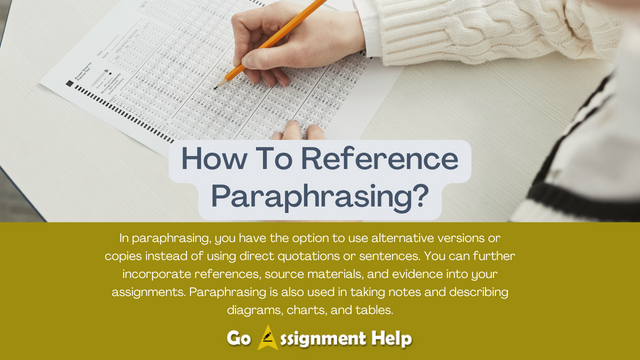How To Reference Paraphrasing?
Feb 24,23
What is paraphrasing?
The way of using different words and phrases to present an already written or spoken message is known as paraphrasing. It is usually used with short texts like sentences and phrases.
In paraphrasing, you have the option to use alternative versions or copies instead of using direct quotations or sentences. You can further incorporate references, source materials, and evidence into your assignments. Paraphrasing is also used in taking notes and describing diagrams, charts, and tables.
Also Read :Nursing Administration Research
When can you paraphrase?
Usually, people paraphrase short sections of text, like a short paragraph or two or a sentence. These are the times when you can use paraphrasing,
- When you want to write an alternative copy to a direct quotation
- When you want to rewrite other people’s ideas without changing the meaning
- When you want to express the ideas of others in your own words
- When you have to provide a reference or evidence, or when you have to support claims made in writing.
How to paraphrase?
Before you start paraphrasing, a few points you will need to keep in mind are.
- Read the original source carefully. Understanding the original copy fully is essential to do correct paraphrasing.
- Understand the subject. Identify the main point(s) and keywords.
- Rewrite the original text in your own words. Do not miss the points in the original text in your content. Check you have not missed information in the original text
- Do paraphrase in your own style. Take every point into consideration while writing. Make points on how you could rephrase it.
- Ensure that you keep the original meaning and maintain the same relationship between the main ideas and supporting points.
- Use correct synonyms wherever you find them appropriate. Keywords that are specific terminology to the subject do not need to be changed.
- Use quotation marks (“”) if you are keen on keeping unique or specialist phrases.
- Change the sentence structure. You can make long sentences short by breaking them, or even join two small sentences and make one. Change word forms (by using nouns and adjectives) and change the voice in sentences (active/passive).
- You can also make modifications to the order in which information/ideas are presented. But make sure they do not lose their essence. The meaning should not be changed from the original copy.
- It is also important to recognize the intent and attitude of the authors toward their subject (i.e., whether it is certain, uncertain, critical, judgmental, etc.). Make sure your paraphrase does not change that intent and attitude, but rather reflects on the paraphrasing. Make use of appropriate words or phrases to describe.
- In the end, when your paraphrasing is complete, review it to check whether it is accurately reflecting the original text. Also, make sure, the text is fully in your words and style.
- Keep a record of the original source, so that when or if required you can provide a reference.
The above tips can be very helpful in guiding you if your task requires paraphrasing.
Also Read : Nursing Degree





0 responses on "How To Reference Paraphrasing?"